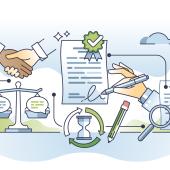
CHEAT SHEET
- Back to basics. To apply artificial intelligence (AI ) technologies into company practice, in-house counsel need two vital components: data, and an algorithm or software to process it.
- The next stage. AI algorithms are used in contract reviews to parse information into clauses, sections, and keywords. These subcategories can then be manually reviewed by an in-house lawyer.
- Further applications. In addition to contract, billing, and litigation, artificial intelligence has important applications in employment and intellectual property law.
- Recognize the benefit. The government of the United Kingdom recognizes the importance of artificial intelligence, and is considering the implementation of an independent commission to ensure that new technologies are socially beneficial to the public.
Mark Zuckerberg, the chairman, chief executive officer, and co-founder of Facebook, is known for setting ambitious New Year’s resolutions. For example, in 2010, Zuckerberg taught himself Mandarin. In 2015, he pledged to read one new book every other week. For 2016, however, Zuckerberg declared perhaps his most ambitious resolution yet: building a voice-controlled artificial intelligence (AI) assistant to run his home.
True to his word, Zuckerberg spent between 100 and 150 hours building his creation, which he named “Jarvis,” after the futuristic AI assistant used by Marvel’s famous “genius, billionaire, playboy, philanthropist” Tony Stark (aka Iron Man). In December 2016, Zuckerberg showcased Jarvis in a video on his Facebook page. The video revealed that his proof-of-concept actually worked. With just a few glitches — the AI, voiced by Morgan Freeman, played music, dimmed lights, toasted bread, operated a t-shirt cannon, and even made jokes.
Of course, this is not the first time we have heard about real-life AI. In fact, AI machine-learning is nearly ubiquitous today, albeit in less flashy forms. For example, various companies such as Google, Netflix, and Amazon use AI to suggest items customers might like based on their past preferences and behavior. However, the reality of AI has recently started to enter mainstream consciousness, and as Zuckerberg concluded in a video with Facebook COO and Leanin.org Founder Sheryl Sandberg, it has just a few years to go before reaching full functionality and adoption. Thus, attorneys have been asking themselves the obvious questions for a while now: how do we take advantage of AI in the legal field? If AI can improve quality of life and increase business returns in other industries, how can it be used to increase efficiency and accuracy in legal departments? And, perhaps most critically, what’s the timeline for AI to become ubiquitous in the legal field, especially in-house?
Lucy Bassli, assistant general counsel, legal operations and contracting at Microsoft, is tackling these issues head on. “We have a lot of things in progress and are heavily engaged in exploring the use of AI to change how we deliver legal services to our business partners across the company,” Bassli explains. “Some legal areas are more obvious and more likely to be a focus. At this point, we are considering a variety of options and have started a pilot most recently in spend management and assisting immigration-related inquiries. So, it is generally equal opportunity to use AI for those areas that are most complemented by such technology,” she adds. Deborah Pursifull, a principal legal IT manager in Microsoft’s IT division, echoes Bassli: “Microsoft has been doing research on AI for over 25 years, so it’s not new to us. We’re actively exploring how to incorporate machine learning components, such as the Cortana suite, to deliver intelligent solutions for our legal team. People want to interact with systems in more contextual and natural ways. Right now, we’re applying AI to content on immigration and international travel, which is hosted on our enterprise legal portal. The goal is to provide an efficient and intuitive ‘finding’ experience for employees who need guidance on job-related legal questions, and to continually learn more about what they are trying to find so we can surface that content. Contracts and e-discovery are probably the next logical areas to explore.”
An attorney’s guide to AI basics
There is no shortage of demand for AI technology, especially in the legal field. In-house departments are increasingly pressured to become more efficient and measure performance. These pressures ensure that every in-house leader will need to consider AI at some point. Thomas Trujillo, who up until recently served as a chief operating officer in Bank of America’s legal department, explains the typical plight: “There is more and more pressure on companies and law departments to evolve and reduce costs. We must balance competing demands and a limited budget. For a forward thinking organization like Bank of America, AI is a natural option to explore to more effectively strike that balance.” Fortunately, a wealth of AI technology is already here, and is rapidly changing and automating the way we practice law, from e-discovery and contract review to compliance and intellectual property management.
Although taking advantage of AI does not require a deep technological background, it is necessary to have a basic understanding of what AI does and how it works. Essentially, AI can transform enormous volumes of data into meaningful insights, outputs, or models without losing the underlying details. AI accomplishes this feat by digesting large amounts of information, learning from the information, and applying that knowledge. To implement AI, a modern legal leader needs two vital components: data, and an algorithm or software to process it.
First, data is essential for any AI. Ultimately, a greater quantity and higher quality of data leads to better AI outputs. Fortunately for legal leaders with AI aspirations, in-house departments are notorious information hoarders, with plenty of data. From billing and corporate information to pleadings and contracts, many in-house departments are a treasure trove of recent and historic data and information. In fact, in-house legal practice in general is the business of data, information, records, and document creation.
Although a legal department will likely have plenty of data to work with, additional data from other sources is even better. A data set can be enhanced and enriched with other data sources, whether publicly available or proprietary. For example, legal data can be combined with quantitative and qualitative data from research, government data, and records from other departments, such as HR information or revenue numbers. And, just like chocolate bars, data sets are better when they’re rich and complete. Missing data may significantly limit an AI algorithm. Some software can identify holes in data sets and impute missing data, but in general it’s better to work with the most complete and enriched data possible.
Second, once a data set is identified, AI can apply a sequence of step-by-step instructions for solving a particular problem. This set of instructions takes the form of “software” or “algorithms.” The software/algorithms find patterns in data, calculate relationships, and extract insights. Statistical models such as regressions, probabilities, and similarity measures are often used to determine relationships between the variables and the outcomes. Some AI methods “learn” by calculating how close they are to a known answer (the training set) and by figuring out lines on curves, using the concept of “gradient descent” determinations.
After algorithms are applied to data, AI produces an “output” or “model.” The output or model may come in the form of a decision tree, classification, cluster grouping, list of prioritized outcomes, list of factors, or numerous other possibilities. These models help users think strategically and manage options more effectively. AI-produced models can help any attorney become a better businessperson, decision-maker, and leader.
Evidently, there’s a lot of arcane math underneath the AI hood — but it isn’t an incomprehensible magic. It’s helpful for attorneys to step outside of their comfort zones and understand coding, math, and statistics. However, a deep understanding of calculus, linear algebra, or matrix decomposition isn’t necessary to reap the benefits of AI.
With these benefits, who wouldn’t want to take advantage of AI? Although predictive AI algorithms and automation are likely still in their infancy, AI can already be used to help in-house attorneys manage their responsibilities much faster and more accurately. Tech giants with access to enormous amounts of data such as Google Inc., Microsoft Corp., Facebook Inc., and Amazon.com Inc. are rumored to be more quietly developing and testing machine-learning applications using their proprietary technology. But the majority of companies are only now beginning to look into this new technology. Some who have taken the leap, however, are optimistic for future implementation. Several of these legal leaders were enthusiastic about sharing their AI plans.
Mike Haven, head of legal operations at Gap Inc., recently joined the company and is developing its legal technology roadmap. “AI is the future but not yet fundamental. When building a new operations program, you have to start with the basics — such as e-billing, contract lifecycle management, and e-signature — and move forward from there. The temptation is to do everything overnight, but you have to pace yourself. It takes time and money. So, it is important to be strategic about what to implement, when, and how,” he says. “However, a lot of the fundamental technologies are beginning to incorporate elements of AI, so it’s something that must be considered from the get-go.” Essential to execution of the technology roadmap is getting the rest of the department on board. Haven adds, “It is also important to socialize the idea of new technology within the legal department. AI is a new concept for many people.”
Alan Bryan, senior associate general counsel — legal operations and outside counsel management at Wal-Mart Stores, Inc., echoes the increasing focus on legal operations and AI in in-house departments. “My role focuses on managing outside counsel and certain legal operations for the company. Over the past year, we have intensely focused on better organizing our data so that we can utilize it to make better decisions about our legal spend. Understanding our data set is critical to our analytics goals and becoming more data-driven in our decision-making. This is all part of a larger effort to maintain and improve operational efficiencies in the management of outside counsel and our legal department.”
Bryan feels there is use for legal AI in Walmart’s future. “I think our leadership is on board, and the interest in embracing AI and new technology comes from the top,” he shares. Bryan adds, “If I had to predict, I would say, or at least hope, that we will be testing and purchasing more AI technology. I see many possible applications and believe we could prioritize those applications with the greatest ROI and those that will help us meet our efficiency goals.”
A broad survey reveals that there are six main legal AI applications that have appeared recently. These AI applications, though still in development, may eventually gain wide adoption and acceptance among in-house attorneys.
E-discovery: The classic AI application that started it all
Although legal and AI have a blossoming relationship, the use of AI in legal work isn’t exactly new. E-discovery tools are considered to be the root of AI in the legal practice, helping lawyers review a large amount of information in a short amount of time. Identifying relevant documents using keyword searches with the aid of AI machine-learning saves time and money, substantially reduces the need for human review, and produces better quality results.
“The legal profession was among the first to apply machine-learning technology and artificial intelligence in practical ways, initially in developing technology-assisted review for e-discovery and then in legal research, contract review, and other applications,” Bob Ambrogi wrote in a recent Above the Law article. “If lawyers aren’t ahead of the curve on AI, they’re certainly near the leading edge of it.”
Trujillo believes e-discovery has yielded the most interesting AI tools so far. “E-discovery provides obvious opportunities for companies to see the savings associated with AI and automation,” he says. “The upfront adoption of tools such as data analytics and predictive coding often reduces costs, increases focus, and leads to a greater impact overall. Some options, however, are better than others. More sophisticated AI tools get smarter as you use them because they are able to learn. For example, consider a company like H2, which has a very sophisticated tool that uses advanced linguistics and algorithms for predictive coding.”
So far, law firms have lead the adoption of these e-discovery tools. Some say, however, that the adoption of AI in e-discovery and other areas has faced challenges, even among law firms, for a few reasons. E-discovery pioneer Maura Grossman, in a profile by The American Lawyer, says that “not all e-discovery products that claim to use machine-learning are equally effective, and some customers have been soured by bad experiences.” Grossman also points to the users as part of the reason why some AI technologies are not living up to their potenital. “Lawyers are generally conservative by nature,” she says. “They don’t want to be the first guinea pig out there experimenting with a new technology.”
Trujillo adds, “Everyone is waiting for courts to adopt artificial intelligence and machine-learning as a new norm. Many lawyers don’t want to embrace it prematurely and do it wrong. They are waiting for guidance from court opinions in order to manage risks and to get more clarity about what rules the courts may require with respect to the use of these tools, for example, what is appropriate to share with other side.”
In-house legal departments, however, may soon be forced to adopt AI e-discovery technology. In 2012, the CSC (Computer Sciences Corporation) reported that by 2020, there will be a 4,300 percent increase in “annual data generation.” The company also reported that 80 percent of data is stored, protected, and managed by enterprises. According to Legaltech News, “Massive data volumes can be both inundating and expensive for companies when receiving discovery requests and undergoing internal investigations.” With this increase in data, it is not hard to imagine that sophisticated in-house departments will have to begin to leverage AI internally to make sense of the ever-increasing amount of data that many legal departments have. Haven, however, is enthusiastic about the capabilities of AI e-discovery tools. “E-discovery tools are very exciting and increasingly advanced. I am certain we will see in-house departments leverage them more in the near future,” he says.
Moreover, e-discovery is often an international adventure. Companies with a global presence and workforce will also be increasingly interested in AI e-discovery capabilities. For example, Brainspace recently released Discovery 54 to provide users with enhanced support for foreign languages such as Farsi, Japanese, and Chinese. This should give users greater discovery capabilities on various international datasets.
Litigation management and research applications: The next frontier of e-discovery
There are a number of litigation management and research AI applications that may soon benefit in-house legal departments as well. These tools are natural extensions of e-discovery and are often related to or integrated with e-discovery tools. For example, Casetext has released its Case Analysis Research Assistant (CARA) — an AI tool for legal research. Other tools have also risen to prominence: ROSS Intelligence’s application of IBM’s Watson technology is able “to skillfully search through information using everyday language rather than legalese” and can be used by a non-lawyer.
Some industries, especially those that are heavily regulated and complex, will reap many benefits from AI algorithms in all stages of document management — from e-discovery and research to litigation, jury selection, automated arguments, and compliance.
For example, AI algorithms can be especially helpful in healthcare and banking. In fact, several AI tools currently exist that are tailored for the specific requirements of these industries. Bryan predicts that AI applications have use in e-discovery, litigation management, research, compliance, internal investigation, and knowledge management, among other possible applications, now and in the future. “I feel strongly that AI has the capability to help us improve effectiveness, efficiency, and accuracy in these areas,” Bryan says.
Contracts: A perfect data stage for AI
Contracts are perhaps one of the most intricate puzzles that in-house legal departments must handle — full of boilerplate language and byzantine organization. Many contracts can be overwhelmingly long, requiring excessive time and energy for even the most skilled lawyers to parse and assess.
Therefore, it’s only natural that AI algorithms are increasingly applied to contract review. AI can parse contract information into clauses, sections, and keywords for easy search and comparison. The information can then quickly be organized. Applying AI algorithms to contracts streamlines review increases accuracy and speed, and decreases costs.
For example, LawGeex’s AI algorithm mimics the way a lawyer’s brain works. LawGeex is a startup that “combines machine learning algorithms, text analytics, and the knowledge of expert lawyers to deliver in-depth contract reviews efficiently and quickly.” According to Cofounder and CEO Noory Bechor, the AI analyzes the language and words of a contract much like how a real attorney would. “The technology can understand, ‘What does this text actually mean?’ and, ‘What is the meaning behind this text?’” he explains in an interview with Legaltech News. This sophistication draws upon a “knowledge base” of similar contracts, rivaling even the sharpest lawyer’s memory. “This technology reads the contract, understands what it says, and reviews the contract in contrast of what it has in the database,” Bechor adds. Then the algorithm compares clauses in the contracts to examples and highlights the differences.
Although AI technology can now analyze language, not just quantitative data, attorneys don’t need to worry about being replaced by a set of robot lawyers. Bechor acknowledges that “while automation can get through a great deal of data very quickly, it can’t fully tailor a contract on its own.” Every contract will still require human review. The AI algorithm creates efficiencies by supporting lawyers, not by replacing them.
There also are numerous other AI contracts solutions beyond the area of contract review. For example, Seal Software, another legal AI startup, claims to gives its users “clear vision into [their] contractual relationships, risks, obligations, and opportunities, so [they] know immediately how those changes affect [their] organization[s].” EBrevia’s Bespoke uses natural language processing technology to learn, identify, and extract industry-specific provisions. Yet another contracts AI tool, Kira Systems, is specifically useful for companies that engage in M&A.
At this time, Haven is part of a cross-functional team reviewing contract lifecycle management offerings, some of which incorporate AI. Among other things, they are looking for software that can cross check contracts to avoid conflicting provisions and obligations. Haven believes this application of AI is especially vital to large in-house departments. “It allows the proverbial left hand to know what the right hand is doing. This is important for all large, global organizations.” He also applauds the learning aspect of the technology, adding: “Software can collect analytics about various provisions. It lets counsel know, in advance, the provisions and alternatives that have been approved or rejected in the past and how often. This reduces time spent on contract negotiation and streamlines execution.” Other in-house departments that choose to adopt this technology are likely to reap similar benefits from the wide range of AI contract solution offerings.
Ginger Dolgow, senior contract management and services manager, legal department at NetApp, explains how the NetApp legal department is leveraging AI technology through its partner, Elevate Services: “The software extracts contract metadata, including approximately 80 contract terms, from NetApp’s revenue contracts. The extracted contract terms are loaded into NetApp’s metadata repository and the transactional terms auto-populate on NetApp’s quotes. In addition, reports on the business terms enable strategic business decisions with unprecedented efficiency and speed,” Dolgow explains. “Historically, this was a time consuming and heavily manual process. We knew it would not scale. Fortunately, our GC, Matt Fawcett, never asks us to ‘do more with less.’ Instead he encourages us to adopt an accelerator mindset and work differently — to take risks, embrace technology, and share our experiences with others (both successes and failures). We are often beta testers for cutting-edge technology in the industry and I had full support to roll out AI technology for our contract extraction process,” Dolgow adds.
According to Dolgow, the use of AI has allowed NetApp’s legal department to provide its business units with critical insight into its contractual obligations in hours, rather than days or weeks. Dolgow’s experience has also yielded several important takeaways with respect to working with and training the AI technology. “AI involves an up-front investment to train the technology. We went live after six weeks. However, we are still in the machine-learning phase today, which means we are still working with the software to increase its accuracy on certain provisions. One of the key learnings from this process — it’s not necessarily the volume of contracts you run through the software that increases the accuracy of the AI, but rather the number of examples per provision you can provide. Once this is stable across all of the contract terms we extract, we will achieve ever greater time and cost savings. We are almost there!” Dolgow enthusiastically explains.
E-billing and legal operations: The evolution of AI algorithms
AI algorithms have evolved to address another major in-house issue: the outstanding mass of legal bills. In-house departments have been exploring the usage of analytics for years to manage their sky-high piles of legal bills. New natural language-based parsing software can quickly review stacks of virtual invoices to mine for various details to improve accountability and overall transparency.
Bryan also explains, “We aim to measure everything, including the performance, spend, and diversity of our outside counsel, as well as many other data points within those categories and beyond. We see it as an opportunity to be more effective and to make better choices.” AI could assist in these efforts, with the added bonus of decreasing expenses. He adds, “It is evident from the little I have seen that AI could have great cost-saving potential in the future. I envision a day when we use technology and AI to help us further conversations with our business clients about the decisions they make and with our outside counsel about the legal services they provide.”
Even in-house departments that are not managing hundreds of outside firms can benefit from AI e-billing. For example, companies such as Viewabill and numerous others provide real-time insight into billing to allow in-house professionals to manage their budgets in real time. While outlooks about e-billing software are mixed, Viewabill Co-founder Alan Dershowitz believes it provides “a winwin situation for clients and lawyers. Everyone can see what’s going on with the bills, and a lot of the conflicts can be avoided.”
The evolution of AI algorithms evident in e-billing software has also been used to create other automated tools. Specifically, legal operations may soon benefit from a proliferation of virtual assistant tools similar to Apple’s Siri and Microsoft’s Cortana. It is easy to imagine a virtual legal assistant that answers phones and automates numerous other legal tasks. For example, Riverview Law recently went live with Kim, a technology that will power Riverview’s Law Virtual Assistants to help in-house teams manage instructions, risk, and work assignment.
Immigration AI: The international in-house game changer
Fortunately, the promise of AI is not limited to contracts and litigation. AI also has important applications in immigration and employment law. Immigration filings may soon be automated with AI and implemented within in-house departments. For example, Visabot, a small, early stage startup, allows users to chat with a robot to navigate the US work visa process. Users answer a series of questions, and the bot evaluates their chances of being granted a work visa in the United States. The bot then guides users toward resources. Using information from users’ LinkedIn profiles, the bot can either estimate users’ chances of obtaining an O-1 visa (a nonimmigrant visa for those who possess extraordinary ability in the sciences, arts, education, business, or athletics), or it can help users extend a B-2 tourist visa. It is also in the process of developing processes around other US immigration visas. Visabot proudly states: “I help immigrants make America great again.” While at this stage Visabot is probably not ready to be deployed within in-house departments, it is not hard to imagine that at some point it may be ready to serve clients’ immigration needs. In the increasingly global industry, this application of AI will be a significant benefit to companies.
Intellectual property: The next AI-rich opportunity?
Intellectual property may be yet another opportunity to use AI algorithms. For example, CPA Global’s IP Platform allows users to more easily aggregate and evaluate IP data. It provides customers with a patent database that boasts more than four million records updated each week. The platform integrates filings, renewals, forecasting, and ideas management. Another application, Lex Machina (acquired by LexisNexis in 2015), mines litigation — often IP litigation — for data. It analyzes unstructured data in docket entry text and court filings to recognize and extract key pieces of information (such as patent numbers of asserted patents), and categorize them. In-house departments in the tech industry could benefit greatly from adopting AI applications for IP litigation and management.
Making sense of the in-house AI landscape
As this brief survey suggests, the number of AI applications in law is already proliferating and in-house departments, widely curious about this new technology, stand to benefit. And this is just the beginning. On the other hand, the rise of these numerous AI applications, though exciting, also leads to a number of concerns. Among them, two in particular stand out: the ethical implications and the security of in-house legal jobs.
When it comes to AI, the ethics issues are numerous, wide, and deep. For example, data protection laws, workplace laws, court decisions, and regulations lag behind the technological advances in AI, creating uncertainty for lawyers looking to embrace new tools and procedures. But the United States is starting to consider the complexities AI growth may cause. Recently, the Obama administration issued a 58-page plan for regulators tasked with overseeing the development of AI. The plan called for “increased public investment and safety measures while acknowledging industry opposition to ‘broad regulation’ of research and practice.” Former US President Barack Obama also urged the government to be active when it comes to AI development, suggesting that as technology advances and matures, the government “needs to be involved a little bit more.”
US-based lawyers are also earnestly looking across the pond to see how the various ethical issues may play out. It looks like the United Kingdom has all the ingredients in place for a successful AI governance framework. The Science and Technology Committee of the UK House of Commons recently published a report recommending that the government fund an independent commission to “develop governance principles and ethical guidelines to ensure AI is ‘socially beneficial.’” The report also recommended that the government consider how to address a looming “digital skills crisis.” On the other hand, the report recognized that the government should refrain “from too much regulation” to avoid stunting rapid growth and change. How the United Kingdom will reconcile these goals in practice will be closely watched and evaluated.
Historically, automation leads to job loss that may or may not be offset through job creation. Thus it is natural for in-house legal professionals to consider the implications of AI on their job security. Some headlines channel this collective concern by stating, “Lawyers, beware. Robots really are coming for your jobs.” In a column for Bloomberg View, engineer Elaine Ou warned that “eventually, human lawyers will be called in to interpret only the rare ambiguity, likely a human-generated flaw that never would have existed if lawyers had used robots in the first place.”
The potential for increased automation, however, is also an opportunity for in-house departments to play a more instrumental role in managing the business side of legal practice. Bryan says, “AI and technology will help us with budget certainty, which is important to the overall business. With better insight and predictability into legal spend and outcomes, we will be better able to advise our business clients.”
It is also an opportunity for in-house attorneys to ask several important questions. What value are we adding now? How we can reach new efficiencies, effectiveness, and accuracy with AI and new technologies? What will the new delivery of legal services look like? What cases and projects do we still need to use outside counsel for? What can we do now to help our business partners thrive and be prepared? And what will a good legal department of the future do differently? These questions may be difficult to answer, but doing so will be a valuable lesson in avoiding complacency.
Microsoft’s Bassli ponders these questions on a regular basis: “While we are still prioritizing and discussing, the next few months will be critical for these opportunities and their implementations. We certainly expect AI and legal tech efforts to take off in the near term. Our department in general is very innovative and Brad Smith, Microsoft’s president and chief legal officer, is an advocate and great supporter in figuring out how the intersection of legal technology and AI can optimally support our business units.” According to Microsoft’s Pursifull, “Key questions that we ask ourselves are, how can we use AI to save time, because that’s a precious commodity — and how do we glean not just information, but intelligence, from all the data around us, and use it to drive smart and innovative business decisions?” While there are countless possibilities, Microsoft is committed to piloting AI to help streamline certain legal projects. “We have a lot of ideas and passion around this, and are actively evaluating the best use cases,” Bassli explains.
Although the future of in-house legal practice may seem uncertain in light of AI development, by focusing on how AI can be of benefit, the profession can evolve by riding the wave instead of resisting. In fact, the entire legal industry may see a shift that allows in-house legal departments to grow, as companies manage a greater volume of work internally, and outsource only certain matters to outside counsel. Ultimately, if in-house counsel choose to adopt and implement AI strategically and intentionally, this new technology will likely lead to a new era of highly sophisticated, well-rounded, and integrated in-house legal departments.
A sample of innovative legal AI technologies
Apttus for contract life-cycle management;
Brainspace Discovery 5.4 providing enhanced foreign language support;
BrightFlag providing useful insights on legal spending;
Casetext Case Analysis Research Assistant (CARA), an AI tool for legal research;
ComplyAdvantage a startup that recently raised $8.2M in a Series A Funding Round and uses AI to identify compliance risks;
CPA Global’s IP Platform allowing users to more easily aggregate and evaluate IP data;
eBrevia’s Bespoke using natural language processing technology to learn, identify, and extract industry-specific provisions;
Elevate Services helping lawyers with legal project management, data analytics and workflow management;
Equivio Zoom a platform for analytics and predictive coding that enables attorneys to zoom in on important data to make sense of cases, pinpoint key documents, cull collections, and organize review;
GEP for contract management;
Guidance Software recently announced the release of its EnCase Big Data Investigator, an e-discovery solution integrated with Brainspace Analytics tools allowing a legal team, investigator, or risk analyst to“[a]pply machine learning analytics and case analysis to support traditional e-Discovery workflow,” according to a press release by Guidance Software;
Ivalua for contract management;
kCura Relativity Analytics software that amplifies e-discovery and data governance efforts with text analytics technology;
Kira Systems is specifically useful for companies that engage in M&A;
LawGeex’s AI algorithm mimicing the way a lawyer’s brain works; Legal Discovery’s CasePoint, an e-discovery platform that aims to harness the power of technology assisted review (TAR) during all stages of e-discovery;
Lex Machina mining litigation for relevant data;
NextAngles has a compliance suite to help financial institutions deal with liquidity and money laundering regulations;
OutsideIQ’s DDIQ technology can help organizations meet the International Organization for Standardization (ISO) anti-bribery standard, ISO 37001;
RAVN Systems’ RAVN Extract Direct, an AI tool that can read, interpret, review, and extract key information from a variety of legal documents;
Riverview’s Law Virtual Assistants helping in-house teams manage instructions, risk, and work assignments;
ROSS Intelligence’s application of IBM’s Watson technology;
Seal Software seeking to optimize contract visibility and insight;
Why Contract Management Is Sexy: A Conversation With Seal Software’s Ulf Zetterberg
Text IQ developing technology that will be “using AI to help companies win lawsuits;”
Viewabill providing real-time billing insight; and,
Visabot allowing users to chat with a robot to navigate the US work visa process.
Additional recommended reading
AI, Robotics, and the Future of Jobs (PEW 2014).
Machine-Learning Algorithms Can Help Health Care Litigation, June 8, 2016.
Artificial Intelligence Set to Transform Regulatory Compliance, September 19, 2016.
eBrevia Launches Bespoke, Offering Custom Contract Analytics, June 16, 2015.
Deloitte Partners with Kira Systems to Bring AI Into the Workplace, March 8, 2016.
Deloitte Partners with Kira Systems to Bring AI Into the Workplace, March 8, 2016.
Top Irish Law Firm to Deploy AI Tech, October 7, 2016.
Five AI Pioneers to Watch, September 29, 2016.
Legal Tech Download: On-Demand Lawyers & Immigration AI.
Artificial Intelligence Has Found a Home in Contract Management, August 4, 2016.
The Wachtell Way of E-Discovery, February 1, 2016.
Why Deep Learning Is Suddenly Changing Your Life, September 28, 2016.







